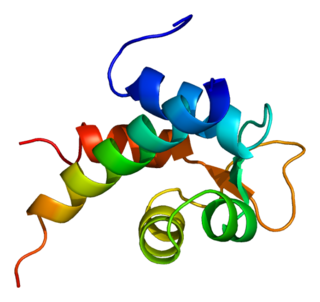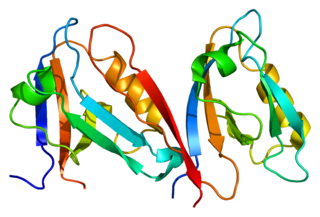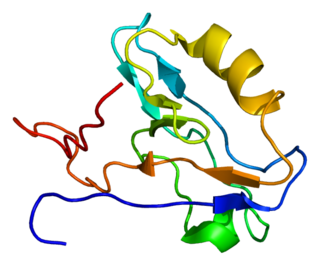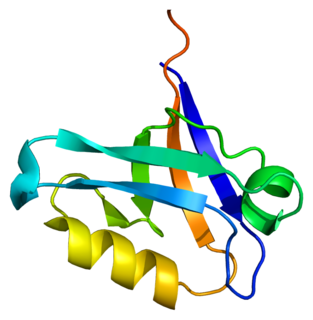
Sodium-hydrogen exchange regulatory cofactor NHE-RF2 (NHERF-2) also known as tyrosine kinase activator protein 1 (TKA-1) or SRY-interacting protein 1 (SIP-1) is a protein that in humans is encoded by the SLC9A3R2 gene.

Alpha-actinin-1 is a protein that in humans is encoded by the ACTN1 gene.

Alpha-actinin-3, also known as alpha-actinin skeletal muscle isoform 3 or F-actin cross-linking protein, is a protein that in humans is encoded by the ACTN3 gene located on chromosome 11. All people have two copies (alleles) of this gene.

Alpha-actinin-2 is a protein which in humans is encoded by the ACTN2 gene. This gene encodes an alpha-actinin isoform that is expressed in both skeletal and cardiac muscles and functions to anchor myofibrillar actin thin filaments and titin to Z-discs.

Alpha-actinin-4 is a protein that in humans is encoded by the ACTN4 gene.

Zyxin is a protein that in humans is encoded by the ZYX gene.

Alpha-1-syntrophin is a protein that in humans is encoded by the SNTA1 gene. Alpha-1 syntrophin is a signal transducing adaptor protein and serves as a scaffold for various signaling molecules. Alpha-1 syntrophin contains a PDZ domain, two Pleckstrin homology domain and a 'syntrophin unique' domain.

PDZ and LIM domain protein 5 is a protein that in humans is encoded by the PDLIM5 gene.

Myotilin is a protein that in humans is encoded by the MYOT gene. Myotilin also known as TTID is a muscle protein that is found within the Z-disc of sarcomeres.

Membrane-associated guanylate kinase, WW and PDZ domain-containing protein 1 is an enzyme that in humans is encoded by the MAGI1 gene.

PDZ and LIM domain protein 7 is a protein that in humans is encoded by the PDLIM7 gene.

Four and a half LIM domains protein 3 is a protein that in humans is encoded by the FHL3 gene.

PDZ and LIM domain protein 4 is a protein that in humans is encoded by the PDLIM4 gene.

LIM domain binding 3 (LDB3), also known as Z-band alternatively spliced PDZ-motif (ZASP), is a protein which in humans is encoded by the LDB3 gene. ZASP belongs to the Enigma subfamily of proteins and stabilizes the sarcomere during contraction, through interactions with actin in cardiac and skeletal muscles. Mutations in the ZASP gene has been associated with several muscular diseases.

Cysteine-rich PDZ-binding protein is a protein that in humans is encoded by the CRIPT gene.

Myozenin-1 is a protein that in humans is encoded by the MYOZ1 gene.

LIM domain-binding protein 2 is a protein that in humans is encoded by the LDB2 gene.

Actin-associated LIM protein (ALP), also known as PDZ and LIM domain protein 3 is a protein that in humans is encoded by the PDLIM3 gene. ALP is highly expressed in cardiac and skeletal muscle, where it localizes to Z-discs and intercalated discs. ALP functions to enhance the crosslinking of actin by alpha-actinin-2 and also appears to be essential for right ventricular chamber formation and contractile function.

PDZ and LIM domain protein 2 is a protein that in humans is encoded by the PDLIM2 gene.

STK35L1 is a protein that in humans is encoded by the STK35 gene. It is a member of the NKF4 Ser/Thr kinases (STK) family and classified in group "Other" in the human kinome. Previously, STK35L1 was named as Clik1 based on a study that showed an association of STK35 with CLP36 after overexpression of both proteins in osteosarcoma cells. Clik1 gene described by Vallenius et al. code for a protein of 501 amino acids. Later, Goyal et al. found that coding sequence of the STK35 gene is incomplete. The newly identified sequence of the STK35 gene codes for a protein of 534 amino acids with a N-terminal elongation of 133 amino acids. It has been designated as STK35L1.



























